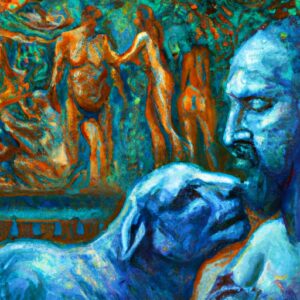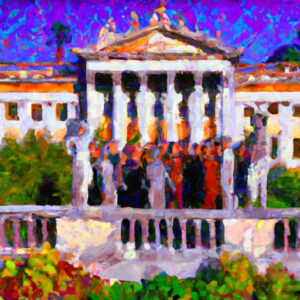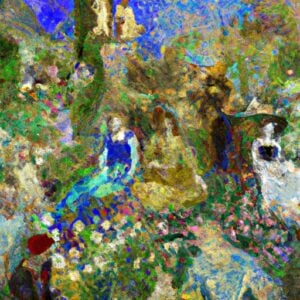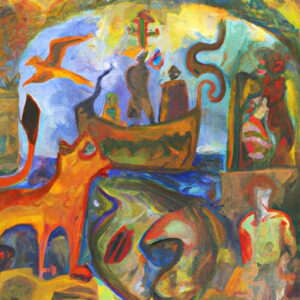.jpg)
Renaissance Italy was a time of great cultural and intellectual flourishing, with advancements in various aspects of daily life. Understanding the different facets of life during this period provides valuable insights into the society of the time. In this article, we will explore various aspects of daily life in Renaissance Italy, including education and intellectual life, family and social structure, work and economy, art and culture, religion and the Church, as well as entertainment and leisure activities.
Education and Intellectual Life played a vital role in the Renaissance era. Humanism, a philosophical movement that emphasized the importance of human potential and achievements, was a significant aspect of Renaissance Italy. The focus on humanistic education led to a revival of classical literature, philosophy, and art. Universities and schools played a crucial role in educating individuals in various fields of study.
Family and Social Structure were deeply rooted in Renaissance Italy. Patriarchy and gender roles were prevalent, with men holding positions of authority and power within the family and society. Marriage and family life were central to social structure, with arranged marriages being common and families playing a significant role in the community.
Work and Economy flourished during the Renaissance. Trade and commerce thrived, contributing to the economic growth of the Italian city-states. Guilds and artisanal professions played a crucial role, ensuring the quality and standards of various industries.
Art and Culture were at the forefront of Renaissance Italy. Renaissance art and artists made significant contributions, with masterpieces created in various mediums. Literature and philosophy also experienced a renaissance, with renowned figures such as Dante Alighieri and Niccolò Machiavelli shaping the cultural landscape of the time.
Religion and the Church played a prominent role in daily life. The Catholic Church held sway over the people’s spiritual lives and exerted significant influence over the political and social realms. Religious festivals and practices were an integral part of the Renaissance culture.
Entertainment and Leisure provided an outlet for leisurely pursuits. Music and dance were highly valued, with performances taking place in various settings. Games and sports were also enjoyed, providing opportunities for physical activity and social interaction.
By delving into the different facets of daily life in Renaissance Italy, we can gain a deeper understanding of the societal, cultural, and intellectual developments that shaped this remarkable period in history.
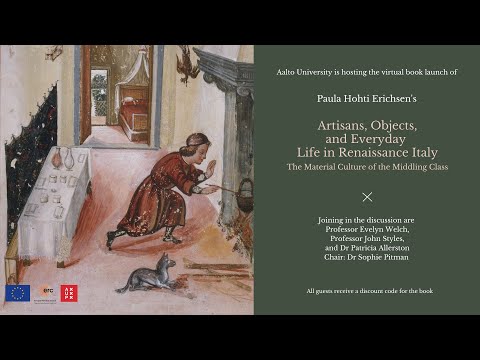
Education and Intellectual Life
Education and intellectual life in Renaissance Italy were rich and vibrant, with two major aspects to explore. First, we’ll dive into the captivating world of humanism, a key cultural movement that shaped thinking and learning. Then, we’ll explore the stimulating environments of universities and schools, where knowledge was cultivated and young minds honed. Uncover the intellectual revolution that fueled the Renaissance era and discover how education played a pivotal role in shaping daily life.
Humanism in Renaissance Italy
Humanism played a significant role in Renaissance Italy. It emphasized the importance of human potential and individualism. Humanists believed in the power of education and the value of classical learning. They sought to revive the knowledge and wisdom of ancient Greek and Roman civilizations. Humanism in Renaissance Italy was not limited to academia but also influenced art, literature, and philosophy.
Italian humanists such as Petrarch and Giovanni Pico della Mirandola championed the study of humanities, including literature, history, and ethics. They believed that education should focus on developing well-rounded individuals who can contribute to society. Humanists valued critical thinking and moral virtue, and they emphasized the importance of using reason and logic in all aspects of life.
Humanism in Renaissance Italy had a profound impact on intellectual development. It led to the rediscovery of ancient texts and ideas, which sparked a cultural revolution. The rise of humanism also led to the creation of new educational institutions and the establishment of libraries for the preservation of knowledge. The movement cultivated a spirit of curiosity and innovation, fueling advancements in various fields.
Humanism in Renaissance Italy was a transformative movement that emphasized the potential of individuals and the value of education. It brought about a renewed interest in classical learning and contributed to the intellectual flourishing of the time. Humanism in Renaissance Italy shaped the cultural and intellectual landscape of the era, leaving a lasting legacy that continues to inspire and influence us today.
Universities and Schools
In Renaissance Italy, universities and schools stood as vital institutions for education and intellectual life. These universities, including the University of Bologna, University of Padua, University of Pisa, and University of Florence, held great prestige during that time. The curriculum at these universities focused on classical subjects like Latin, Greek, rhetoric, and philosophy, while also covering mathematics, natural sciences, and medicine.
Family and Social Structure
Family and social structure during the Renaissance in Italy offers a captivating glimpse into the past. From patriarchal power dynamics to the intricacies of marriage and family life, this section will take you on a journey through the fascinating intricacies of Renaissance society. Delve into the roles and expectations based on gender, uncover the customs and traditions that shaped marriages, and gain insight into the dynamics that governed family life during this remarkable era of history.
Patriarchy and Gender Roles
In Renaissance Italy, the dominant force shaping gender roles was patriarchy and gender roles. These gender roles were strictly defined, with men holding the majority of power and authority. They were considered the head of the household and had control over important decisions. Conversely, women were expected to adhere to traditional roles as wives, mothers, and homemakers.
In this society, women were expected to be obedient, submissive, and primarily focused on domestic tasks. Pursuing education or engaging in public life was discouraged for them. Their main responsibility lay in bearing children and managing the household.
The reinforcement of these gender roles stemmed from societal norms, expectations, as well as legal and religious institutions. Women had limited legal rights and were subject to the authority of either their fathers or husbands.
However, it is important to acknowledge that the experience of patriarchy and gender roles varied based on factors such as social class and individual circumstances. Women belonging to noble or wealthy families had more opportunities to exert influence and pursue cultural and intellectual interests.
In Renaissance Italy, patriarchy and gender roles played a significant role in shaping the lives of both men and women. They dictated the specific roles and responsibilities individuals had based on their gender.
Marriage and Family Life
Marriage and family life in Renaissance Italy were profoundly influenced by societal norms and expectations. The institution of marriage held immense importance for both personal and economic reasons. Families played a pivotal role in arranging marriages, often based on social class and economic considerations. Marriage contracts served as legally binding agreements that delineated the entitlements and obligations of both partners.
1. Marriage and dowry: Marriage was perceived as a means to solidify alliances between families and elevate social standing. Parents carefully selected suitable partners for their children, and dowries were bestowed by the bride’s family to ensure financial security for the couple. The magnitude of the dowry often hinged on the affluence and social status of the involved families.
2. Gender roles and expectations: Renaissance society adhered to a patriarchal structure, with distinct gender roles and expectations. Men were anticipated to be providers and decision-makers, while women assumed the responsibilities of managing the household and raising children. Women possessed limited legal rights and were expected to exhibit obedience and submissiveness towards their husbands.
3. Family dynamics: The family unit was regarded as the bedrock of society, and extended families frequently resided together. Multiple generations coexisted in the same household, and grandparents actively participated in the upbringing of children. Family honor and reputation held great value and were strongly safeguarded.
4. Procreation and lineage: The primary objective of marriage was to procreate and perpetuate the family lineage. Having children, particularly sons, was deemed essential for preserving family wealth and status. Infidelity and barrenness were strongly disapproved of and could result in social exclusion.
5. Religion and marriage: The Catholic Church assumed a significant role in regulating and sanctifying marriages. Couples were obliged to undergo premarital counseling and obtain the Church’s blessing. Divorce was infrequent and heavily discouraged, with separation and annulment being the more prevalent alternatives.
Marriage and family life in Renaissance Italy mirrored the values and social structures of that era. While individuals faced certain expectations and constraints, the institution of marriage remained vital for society’s stability and continuity.
Work and Economy
In Renaissance Italy, the work and economy were buzzing with activity. Trade and commerce played a vital role, while guilds and artisans thrived in their craft. Discover the vibrant world of commerce, where merchants navigated bustling markets, and artisans honed their skills to create intricate masterpieces. Join us as we journey into the fascinating realm of work and economy in Renaissance Italy, where trade and craftsmanship shaped daily life.
Trade and Commerce
Trade and Commerce played a significant role in Renaissance Italy, contributing to its economic growth and cultural exchange. Here are some key aspects to consider:
- Merchant Guilds: Merchant guilds were crucial for regulating trade and protecting the interests of merchants. They set standards for quality control, established fair prices, and resolved disputes.
- Textile Industry: The textile industry was a major contributor to Italy’s economy during the Renaissance. Italian cities like Florence and Venice were renowned for their production of luxurious fabrics such as silk and velvet.
- Banking and Finance: Italian banking families like the Medici played a vital role in facilitating trade by providing loans and financing voyages of exploration. They also introduced new financial practices such as double-entry bookkeeping.
- Maritime Trade: Italian city-states, especially Venice and Genoa, were known for their maritime trade routes. They traded goods like spices, silk, and precious metals with the Ottoman Empire and other nations, contributing to the wealth and cultural exchange of Renaissance Italy.
- Mercantile Cities: Cities like Florence, Venice, and Milan became prosperous mercantile centers due to their strategic locations and trading networks. They attracted merchants from all over Europe, fostering a cosmopolitan atmosphere.
In the bustling city of Florence, trade and commerce flourished. One prominent example is the Medici family, who rose to power through their successful banking and trading enterprises. Their wealth and influence fueled the patronage of artists and scholars, contributing to the cultural and artistic achievements of the Renaissance. The art and architecture that adorned the city’s streets were often commissioned by wealthy merchants, showcasing their prosperity and taste. The bustling markets and trading posts provided the backdrop for daily life in Renaissance Italy, where a diverse array of goods from across the world were bought and sold. This vibrant commercial landscape not only boosted the economy but also fostered a rich exchange of ideas and cultural influences, making trade and commerce an integral part of Renaissance Italy’s legacy.
Guilds and Artisans
When examining the topic of Guilds and Artisans in Renaissance Italy, it is crucial to understand the significance of these organizations and their impact on society.
- Guilds: Guilds were associations or organizations that brought together individuals who worked in the same trade or craft. They played a central role in regulating and maintaining quality standards in their respective industries. Members of a guild would work together to protect their interests, set prices, and ensure fair competition.
- Artisans: Artisans were skilled craftsmen who created unique and high-quality goods by hand. They were highly respected in society and often belonged to guilds. Artisans specialized in various crafts such as carpentry, metalworking, glassmaking, and textile production. They were known for their expertise and craftsmanship, and their creations played a significant role in the cultural and economic development of Renaissance Italy.
Pro-tip: If you’re interested in learning more about guilds and artisans in Renaissance Italy, explore the historical records and archives related to specific guilds. These documents can provide fascinating insights into the regulations, practices, and artistry of the artisans of that time.
Art and Culture
Step into the vibrant world of Renaissance Italy and immerse yourself in the captivating realm of Art and Culture. From Renaissance Art and Artists to Literature and Philosophy, we will take a whirlwind journey through the rich tapestry of artistic expression and intellectual exploration that defined this remarkable era. Discover the innovators, the masterpieces, and the ideas that shaped the cultural landscape of Renaissance Italy. Brace yourself for a captivating exploration of creativity, beauty, and the power of the human imagination.
Renaissance Art and Artists
Renaissance art and artists played a significant role in the cultural and artistic development of Renaissance Italy. During this period, Renaissance Art and Artists underwent a remarkable transformation, embracing new techniques, styles, and subject matter.
Some key aspects of Renaissance art and artists include:
- Humanism influence: Renaissance artists were inspired by the humanist philosophy, emphasizing the importance of human beings and their achievements. This led to the exploration and representation of realistic human figures in their artworks.
- Revival of classical techniques: Renaissance Art and Artists, such as Leonardo da Vinci and Michelangelo, studied and incorporated the techniques of ancient Greek and Roman art. They perfected methods like perspective, chiaroscuro (use of light and shadow), and anatomical accuracy.
- Portraiture and religious art: Portraiture became popular during the Renaissance, aiming to capture the likeness and personality of individuals. Religious art remained significant, with Renaissance Art and Artists depicting biblical scenes and religious figures with naturalism and emotion.
- Secular and mythological themes: Renaissance Art and Artists also explored secular and mythological themes, inspired by classical literature and mythology. These artworks often celebrated beauty, love, and heroic deeds.
- Patronage system: Many Renaissance Artists relied on the patronage of wealthy families, such as the Medici family, to support their work. This allowed Renaissance Art and Artists to create masterpieces and contributed to the flourishing of Renaissance art.
One captivating story from the Renaissance art world revolves around the renowned artist, Leonardo da Vinci. Leonardo is known for his masterpiece, the Mona Lisa. Legend has it that Leonardo carried the painting everywhere he went, constantly working and perfecting it until the end of his life. The Mona Lisa is admired for its enigmatic smile and exquisite detailed technique, showcasing Leonardo’s innovative artistic approach. This painting captures the essence of Renaissance art by combining realism, depth, and psychological depth, leaving a lasting impact on the art world.
Literature and Philosophy
Literature and philosophy were essential components of the Renaissance in Italy, playing a crucial role in the intellectual and cultural flourishing of the era. Italian writers and thinkers produced significant literary works and philosophical ideas that left a lasting impact on European thought.
1. Literary Works: During the Renaissance, Italy saw the emergence of some of the most renowned literary works. Dante Alighieri’s Divine Comedy, an epic poem, adeptly explored theological and philosophical themes. Giovanni Boccaccio‘s Decameron, a collection of stories, provided valuable insights into the social and moral aspects of the time. Niccolo Machiavelli‘s The Prince, on the other hand, offered astute political advice and analysis.
2. Humanist Influence: Humanism, a philosophical movement, held human reason and critical thinking in high regard. Humanist scholars like Petrarch and Pico della Mirandola endeavored to revive classical knowledge and applied it to a variety of disciplines, including literature and philosophy.
3. Exploration of Human Nature: Renaissance authors delved deep into the realm of human emotions and experiences. For example, Francesco Petrarch‘s sonnets eloquently explored themes of love and longing, while Baldassare Castiglione‘s The Book of the Courtier presented an idealized portrait of a Renaissance gentleman.
4. Philosophy and Ethics: Renaissance Italy served as a center for philosophical discussions. Marsilio Ficino‘s revival of Platonism rekindled interest in moral and ethical philosophies. Giordano Bruno pushed the boundaries of rationalism, daring to challenge established religious doctrines.
5. Impact on European Literature: Italian Renaissance literature had a profound influence on European literary traditions. William Shakespeare, for instance, drew inspiration from Italian plays and adapted them into his own acclaimed works.
Literature and philosophy played a central role in Renaissance Italy, fostering intellectual growth and shaping intellectual discourse. The literary works and philosophical ideas that emerged during this period continue to be appreciated and studied today.
To further explore Renaissance literature and philosophy, it is worth examining other notable authors and their contributions to the intellectual and cultural milieu of the time.
Religion and the Church
Religion and the Church in Renaissance Italy take center stage as we delve into the captivating world of spiritual practices and beliefs. From the prominent role of the Catholic Church to the vibrant religious festivals and practices, we embark on a journey that explores the profound influence of faith on daily life during this remarkable period. Discover the religious fervor, traditions, and customs that shaped Renaissance Italy and get a glimpse into the spiritual fabric of society.
Catholic Church in Renaissance Italy
The Catholic Church played a significant role in Renaissance Italy, exerting influence over both religious and political affairs. During this time, the church was a dominant force and held immense power over the lives of the people. It was deeply involved in the daily life of individuals, providing spiritual guidance and shaping moral values. The church’s teachings and rituals were central to the lives of the people, with attendance at mass and adherence to religious practices being expected.
The Catholic Church in Renaissance Italy was not without controversy. The corruption within the church, particularly among high-ranking officials, led to criticism and calls for reform. It also produced great thinkers and intellectuals, such as St. Thomas Aquinas and St. Catherine of Siena, who made significant contributions to theology.
During this period, the church also played a role in the arts, commissioning artwork and architecture to enhance the grandeur of religious spaces. It served as a patron to famous Renaissance artists like Michelangelo and Leonardo da Vinci, promoting the spread of artistic achievements.
The Catholic Church in Renaissance Italy held immense power and influence over the lives of the people. Its teachings and rituals shaped daily life, while its involvement in art and architecture enhanced the cultural landscape of the time. A fascinating fact is that the Council of Trent, held between 1545 and 1563, was a significant event in the Catholic Church’s response to the Protestant Reformation, affirming traditional Catholic doctrine and instituting reforms that helped shape the church for centuries to come.
Religious Festivals and Practices
Religious Festivals and Practices were an imperceptible part of quotidian existence in Renaissance Italy, delivering a sense of togetherness, spirituality, and cultural identity. These festivals were often distinguished by religious processions and ceremonies, embodying the essence of the community. Amidst these jubilations, the Feast of Corpus Christi stood out as an exceptional celebration, emphasizing the significance of the Eucharist through intricate processions traversing the streets. Another vital religious event in Renaissance Italy was Easter, an occasion commemorating the resurrection of Jesus Christ. During this time, churches bloomed in the splendor of flowers, coupled with special services dedicated to this holy period.
Religious practices held a central place in the daily lives of Renaissance Italians, compelling regular attendance at Mass and the regular reception of sacraments. Devotional practices, namely prayer and the veneration of saints, played a momentous role in nurturing personal spirituality. Additionally, the popularity of pilgrimages to renowned holy sites such as Rome or Santiago de Compostela remained prominent.
While acknowledging the importance of religious festivals and practices, it is crucial to note that the Catholic Church in Renaissance Italy encountered critical scrutiny and underwent noteworthy transformations. The Council of Trent, a significant ecclesiastical council convened between 1545 and 1563, was conducted with the aim of addressing the challenges presented by the Protestant Reformation while reaffirming the doctrines and principles of the Catholic Church.
Entertainment and Leisure
In Renaissance Italy, entertainment and leisure activities played a crucial role in the daily lives of people. With a focus on music and dance, as well as games and sports, this section uncovers the vibrant and exciting world of leisure during that time. Get ready to discover the captivating melodies, lively dances, thrilling games, and adrenaline-pumping sports that enthralled and captivated the people of Renaissance Italy.
Music and Dance
When it comes to music and dance in Renaissance Italy, it was an era filled with vibrant melodies and graceful movements. Here are some key aspects:
- Music: Music played an essential role in the daily life of Renaissance Italians. It was performed in various settings, including courts, churches, and private ceremonies. The music was predominantly vocal, with choral and solo compositions being popular. Instruments such as lutes, flutes, and harpsichords accompanied the singers.
- Dance: Dance was not just a form of entertainment but also a social activity. It was an integral part of celebrations, weddings, and courtly events. Different dance forms emerged, including energetic court dances like the galliard and elegant social dances like the pavane. Elaborate costumes and precise footwork characterized Renaissance dances.
- Social gatherings: Music and dance were at the center of social gatherings during the Renaissance. Whether it was a lavish ball in a palace or a joyous village festivity, music and dance were integral elements. They brought people together, fostered a sense of community, and provided an outlet for creativity and expression.
- Influence on art: The influence of music and dance extended beyond their performance. They inspired renowned artists of the time, such as Leonardo da Vinci and Botticelli, who depicted scenes of musicians and dancers in their paintings. The connection between music, dance, and visual arts reflected the interconnectedness of various forms of artistic expression in Renaissance Italy.
In the rich tapestry of Renaissance Italy, music and dance held a special place, bringing people together and adding vibrancy to their daily lives.
Games and Sports
- In Renaissance Italy, games and sports were an integral part of daily life.
- Popular outdoor games, such as calcio storico (a violent form of football) played in Florence, and pallone col bracciale (a game where players hit a ball against a wall using a metal brace on their arm), were enjoyed.
- Both men and women participated in archery, a well-liked sport, and competitions were organized to showcase skill and accuracy.
- Noble and wealthy families often indulged in hunting as a sport, pursuing animals like deer, boar, and birds.
- Indoor games, including the highly favored chess by the elite, as well as card games like tarot and trionfi, were also prevalent.
- Jousting, a popular sport among the nobility, involved combat on horseback and was frequently held during special occasions and festivals.
One captivating true story from Renaissance Italy involves an infamous game of calcio storico that occurred in 1574 in Florence. The match, between the Santa Croce and Santo Spirito neighborhoods, was filled with tension. However, it quickly transformed into a chaotic street brawl, involving hundreds of players and spectators. Lasting for several hours, the brawl caused numerous injuries and even fatalities. This extreme display of passion and competitiveness exemplifies the profound significance of games and sports in Renaissance Italian society.
Frequently Asked Questions
What was daily life like in Renaissance Italy?
Daily life in Renaissance Italy was characterized by a mix of medieval traditions and emerging modernity. Italian city life flourished during this period, with cities transforming from dark medieval cities to bright cities of marble. Weddings were elaborate and emulated the customs of the rich, with even peasants needing to provide a dowry. Women had more freedom of movement and were expected to raise educated sons, while daughters required expensive dowries. The cuisine saw the beginnings of modern concepts of food, and festivals celebrated both religious and secular events.
What cultural achievements were made during the Renaissance?
The Italian Renaissance saw significant cultural achievements in various fields. In literature, famous poets made significant contributions to the world of literature. The fine arts, including works by renowned artists like Leonardo, Michelangelo, and Raphael, were heavily influenced by ancient Greece and Rome, as well as the Catholic Church. Renaissance architecture, exemplified by masterpieces like Michelangelo’s David, still influences modern architecture today. The Renaissance also marked a period of cultural and intellectual growth in Europe, characterized by a revival of interest in classical learning and the arts.
What impact did the Medici family have on the Renaissance?
The Medici family played a significant role in the Renaissance as wealthy patrons of the arts and sciences. They provided financial support to artists, scholars, and architects, allowing them to flourish and create their masterpieces. The Medici family’s patronage contributed to the cultural and intellectual growth of the Renaissance, particularly in Italian city-states like Florence.
How did the Age of Exploration influence the Renaissance?
The Age of Exploration, led by explorers like Christopher Columbus, had a profound impact on the Renaissance. It opened up new trade routes, bringing wealth and knowledge from other parts of the world to Europe. The exploration of new lands and encounters with different cultures enriched European societies, influencing their perspectives and sparking intellectual endeavors.
What were the social and legal structures in Renaissance Italy?
In Renaissance Italy, the social order was largely based on a system of hierarchies and social contracts. Marriage during this time was more of a social contract between families, and weddings were presided over by a magistrate rather than a priest. The legal system was largely based on Roman civil law, with influence from religious authorities. The social order was structured with distinct roles and expectations for men and women, with women having limited rights and opportunities compared to men.
How did the Northern Renaissance differ from the Italian Renaissance?
The Northern Renaissance, which took place in countries outside of Italy, shared some similarities with the Italian Renaissance but also had distinct characteristics. While the Italian Renaissance was heavily influenced by ancient Greece and Rome, the Northern Renaissance drew inspiration from the recently rediscovered works of the medieval and Christian traditions. The Northern Renaissance also had a stronger focus on social and cultural issues, reflecting the unique contexts and concerns of Northern European societies during that time.


